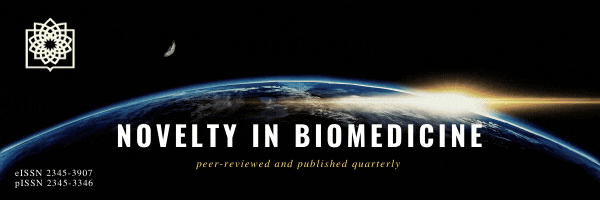Cocaine, Marijuana, Hypertension and Cardiovascular Effects
Novelty in Biomedicine,
Vol. 3 No. 3 (2015),
22 Tir 2015
,
Page 155-159
https://doi.org/10.22037/nbm.v3i3.9508
Abstract
Cocaine is used by more than 14 million people worldwide, about 0.3 percent of the global population age is 15 to 64 years. After alcohol, cocaine is the most common cause of acute drug-related emergency department visits in the United States. Cocaine consumption is more frequently associated with acute cardiovascular illness. Cocaine stimulates α1, α2, β1 and β2 adrenergic receptors through increased levels of norepinephrine and a lesser extent epinephrine. The cardiovascular effects of cocaine are thought to be similar and regardless to the route of consumption. An acute coronary syndrome is the most common cardiac problem including myocardial ischemia and infarction even in young persons without atherosclerosis, aortic dissection and rupture, arrhythmias, ventricular tachycardia and fibrillation, asystole and finally sudden death. Other cardiovascular effects that caused by cocaine include coronary artery aneurysm, palpitation, sinus tachycardia, increased systemic vascular resistance and hypertension crisis, left ventricular hypertrophy, myocarditis, cardiomyopathy, myocardial fibrosis, bundle branch block, heart block, supraventricular arrhythmia, accelerated atherosclerosis, hypotension, bradycardia and infective endocarditis among intravenous users.
Cocaine by three mechanisms cause ischemia: 1. increased myocardial oxygen demand, 2. decreased coronary blood flow due to coronary artery vasoconstriction and spasm and 3. Coronary artery thrombosis via activation of platelets, stimulation of platelet aggregation and potentiation of thromboxane production.How to Cite
References
Bonow RO, Mann DL, Zip D, et al. Braunwald,s Heart disease. Ninth ed., Elsevier Saunders. 2012;1254:1631-4.
Sadock BJ, Sadock VA, Ruiz P, Kaplan, Sadock S. Comprehensive text book of psychiatry. Ninth ed., Lippincott Williams and Wilkins. 2009;1309-30.
Sadock BJ, Sadock VA. Kaplan and Sadock Synopsis of psychiatry. Tenth ed., Lippincott Williams and Wilkins. 2007;1294:421-7.
Cannabis use disorder: Epidemiology, comorbidity and pathogenesis. Uptodate, Version 19.3
Shannon MW, Borron SW, Burns MJ. Clinical management of poisoning and drug overdose.4th ed., Elsevier Saunders. 2007;747-65.
Irwin RS, Rippe JM. Intensive care medicine. Fifth ed., Lippincott Williams and Wilkins. 2003;1429-31.
Cooper DH, Krainik AJ, Lubner SJ, et al. The Washington manual of medical therapeutics. 32nd ed., Lippincott Williams and Wilkins. 2007:753.
Hoffman RS, Nelson LS, Howland MA, et al. Goldfrank,s manual of toxicologic emergencies.Mc Graw Hill. 2007;633-9,675-8.
Longo DL, Fausi AS, Kasper DL. Harrison,s principles of internal medicine.18th ed., Mc Graw Hill. 2012;3556-8.
Andreoli TE, Benjamin I, Criggs RC., et al. Cecil essentials of medicine.8th ed., Elsevier Saunders. 2010;1230-1.
Kaplan NM, Flynn JT. Clinical hypertension. Ninth ed., Lippincott Williams and Wilkins. 2006;455-76.
- Abstract Viewed: 990 times
- PDF Downloaded: 1095 times
